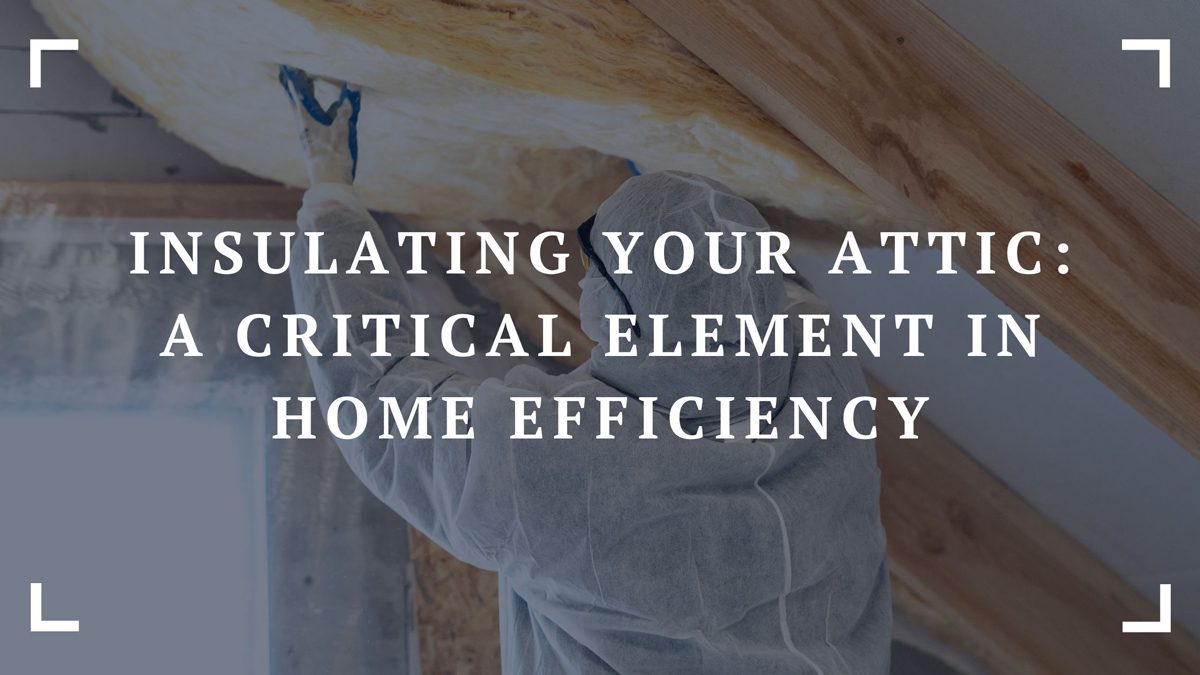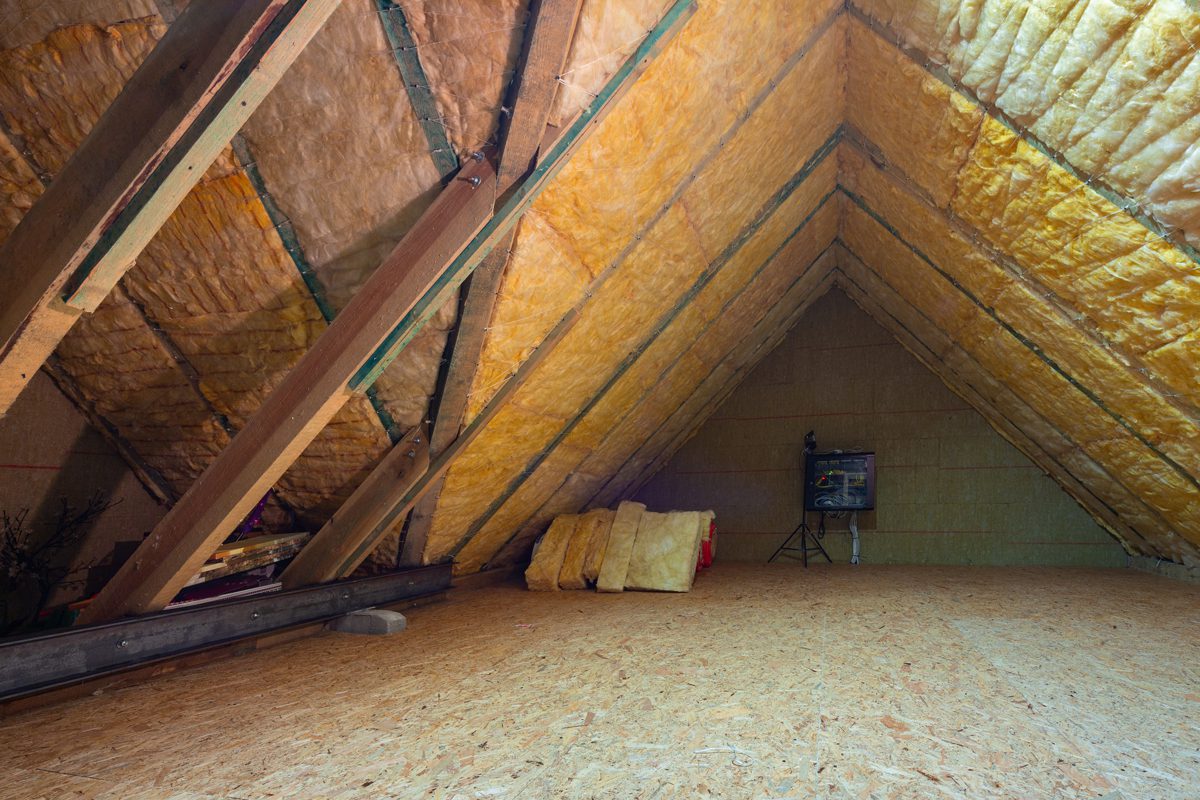Energy efficiency isn’t just a buzzword; it’s a goal every homeowner aspires to achieve. Why? Because being energy efficient means you’re not only saving money but also enhancing the comfort of your home and doing your part for the planet.
It’s about making your home work smarter, not harder, using less energy to power your daily life. And the journey to a more energy-efficient home often starts with a look upwards—towards your attic.
Let’s explore how insulating this critical area can be a game-changer in your quest for energy efficiency, comfort, and cost savings.

Understanding Insulation
Insulation is pivotal in building an energy-efficient home as the first defense against energy loss. It’s essentially the thermal envelope that wraps your home, keeping the indoor climate comfortable and stable, regardless of what’s happening outside.
Here’s why insulation is so crucial in the energy efficiency journey:
Reduces Heat Transfer: Insulation slows down the movement of heat, keeping warm air inside during the winter and hot air outside during the summer. This means your heating and cooling systems don’t have to work overtime to maintain a comfortable temperature, reducing energy consumption and costs.
Lowers Your Utility Bills: By maintaining a stable indoor temperature, insulation reduces the need for heating and cooling, which can account for a significant portion of your monthly energy bill. Well-insulated homes use less energy, lower utility bills, and provide substantial savings over time.
Enhances Comfort: Insulation contributes to a more comfortable living environment by eliminating drafts and reducing the temperature fluctuations that can make rooms feel too hot or cold. This means you can enjoy a consistently comfortable home all year round.
Reduces Carbon Footprint: Insulation reduces greenhouse emissions associated with heating and cooling by decreasing energy consumption. This makes your home not only energy-efficient but also more environmentally friendly.
Increases Home Value: Homes with high energy efficiency are increasingly valued in the real estate market. Insulation improves a home’s energy performance, boosting its value and appeal to potential buyers.
Why Attic Insulation Is Important
Insulating your entire home is a smart move, but why does the attic, in particular, demand attention? Well, it’s because of its strategic position at the top of your house.
The attic is a critical area where heat rises and escapes or enters, depending on the season. In the winter, warm air from your living space naturally rises and can escape through an uninsulated attic, leading to higher heating costs. In summer, the sun heats your roof, turning the attic into a hot box that can radiate heat downwards, making your air conditioning work harder.
In cold climates, a poorly insulated attic can form ice dams on the roof. Heat escaping from the attic melts the snow on the roof, which refreezes at the eaves and prevents proper drainage, potentially leading to water damage.
Because so much of a home’s heat can be lost or gained through the attic, insulating it can lead to significant energy savings. Reducing the demand on your heating and cooling systems extends their lifespan and slashes your energy bills. It’s an investment that pays off month after month.
Transitioning From Why To How: The Attic Insulation Process
Understanding why attic insulation is so crucial sets the stage for the actual process of insulating your attic. It’s the difference between simply throwing a blanket over your home and strategically wrapping it in a thermal barrier that guards against energy loss.

So, let’s roll up your sleeves and explore the steps involved in properly insulating your attic, ensuring that all the benefits of this critical home improvement project are fully realized.
1. Assessment
The assessment phase is the critical step in the attic insulation process. It’s all about understanding the current state of your attic and setting the stage for a successful insulation upgrade.
Current Insulation Evaluation: Determine any existing insulation’s type, thickness, and condition. It may need to be removed or supplemented if it’s damaged or insufficient.
Identify Air Leaks: Find drafts using your hand, incense stick, or a thermal leak detector. Common areas include around chimney flues, recessed lighting, and HVAC ducting.
Moisture Check: Look for signs of dampness, mold, or mildew. These can compromise insulation effectiveness and should be resolved before proceeding.
2. Choose Insulation Type
Choosing the right type of insulation for your attic is like selecting the best winter coat for your home. As you weigh your options, consider factors such as your climate, the existing structure of your attic, and your long-term energy goals.
In this critical decision-making process, you may consult with local experts, such as insulation contractors Madison WI, who can provide valuable insights based on your specific regional needs and home structure.
This stage is about finding the perfect fit to keep your home cozy, reduce energy bills, and provide lasting benefits. Let’s explore the most common types of insulation and help you determine which is best suited for your attic space.
Fiberglass Batts: They’re easy to install, but ensure they fit snugly without compressing. They work best in areas with standard joist spacing.
Loose-fill (Blown-In) Insulation: It requires a particular machine but can provide a complete fill over an irregular attic floor and around obstructions.
Spray Foam Insulation: Provides excellent air sealing and insulation but requires professional installation. Consider open-cell for its moisture permeability or closed-cell for added structural strength.
3. Determining R-Value
Determining the R-value for your attic insulation is crucial in ensuring optimal energy efficiency and comfort in your home. Think of the R-value as the measure of your insulation’s ability to resist heat flow, with higher numbers indicating greater effectiveness.
Climate Consideration: Colder climates require higher R-values for optimal insulation. Check the Department of Energy’s recommendations for your region.
Attic Usage: To convert your attic into a living space, you might need a higher R-value to ensure comfort.
4. Preparation
Consider this phase laying the groundwork for a successful insulation project, where attention to detail will pay off in the long run.
Sealing Leaks: Use foam sealant for larger gaps and silicone caulk for smaller cracks. Pay special attention to the areas around vent pipes, electrical cables, and light fixtures.
Ensuring Ventilation: Install rafter vents or baffles to maintain airflow from the soffits to the attic. Proper ventilation protects against moisture and extends to the life of your roof.
Safety Precautions: Clear the attic of any debris or storage items. Ensure you have a stable platform to work on and that the lighting is adequate.
5. Installation
This step is where your attic insulation plan comes to life. This step requires precision, patience, and attention to detail to ensure the insulation is laid out evenly and effectively.
Whether tackling the project yourself or bringing in professionals, understanding the installation process and its importance will help ensure that your insulation performs at its best, providing maximum comfort and energy efficiency for years.
Let’s walk through the critical considerations and techniques for a successful insulation installation.
Direction And Layering: Lay batts or rolls perpendicular to the joists over existing insulation. With loose fill, use the machine to distribute the material evenly.
Depth And Coverage: Ensure you achieve the uniform depth required for the desired R-value. Avoid leaving any gaps or areas of compression.
Special Considerations: Keep insulation away from recessed lighting fixtures and exhaust fans unless they’re rated for insulation contact.
6. Post-Installation
The post-installation phase is all about ensuring the quality and effectiveness of your newly installed attic insulation. It’s a time for careful inspection and any necessary adjustments to address gaps or uneven coverage. This step is crucial in solidifying the benefits of your insulation efforts, ensuring that your attic remains a stronghold of energy efficiency and comfort.
7. Maintenance
Regular maintenance is the key to sustaining the effectiveness of your attic insulation over time. It involves routine inspections and prompt repairs to address settling, moisture, or damage.
By staying vigilant and caring for your insulation, you ensure that it continues to perform at its best, keeping your home comfortable and energy-efficient for years to come.
Final Thoughts
In conclusion, insulating your attic is a decisive step toward enhancing your home’s energy efficiency, comfort, and value. By investing time and resources into this critical home improvement project, you’re not only creating a more comfortable living space but also contributing to a more sustainable and cost-effective future.
Remember, a well-insulated attic is a testament to a well-cared-for home. So, embrace the journey of attic insulation and enjoy the lasting benefits it brings to your life and home.


